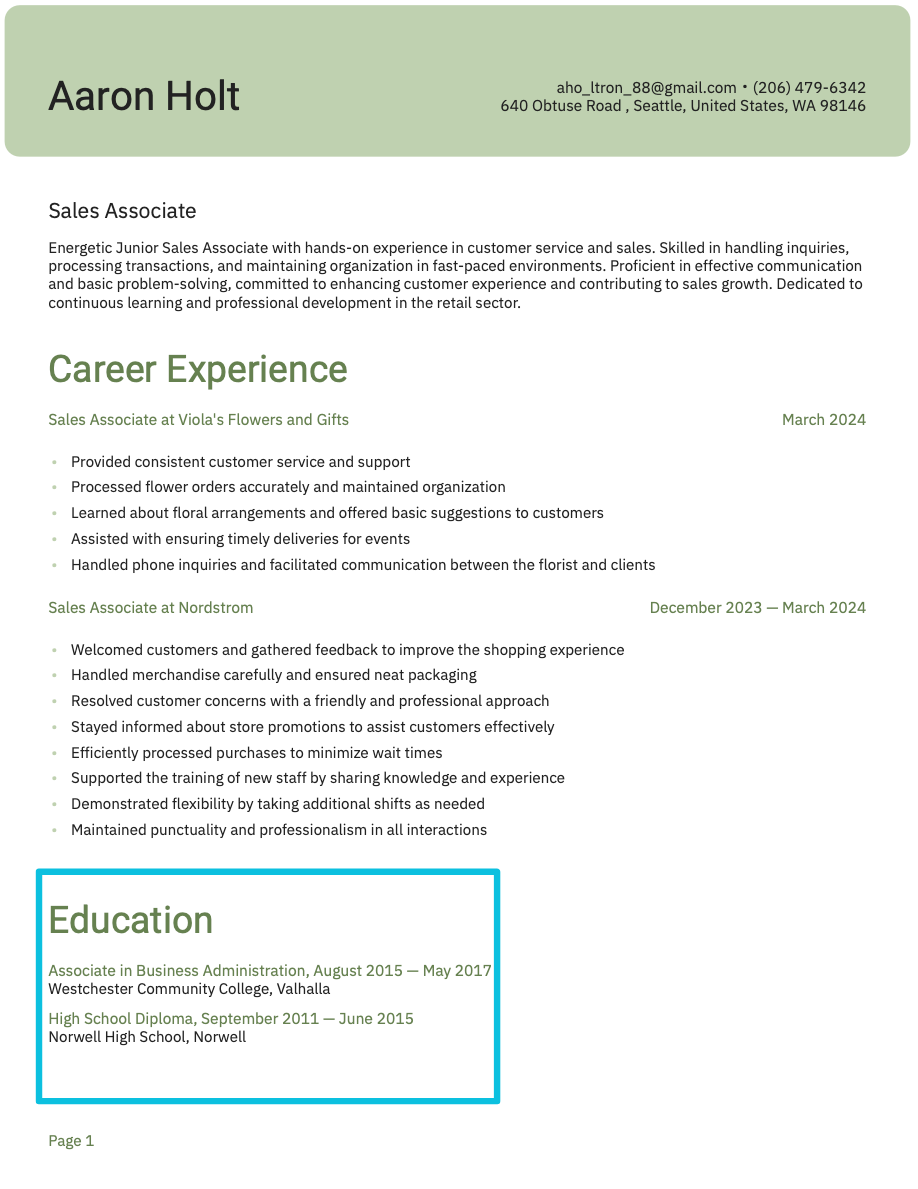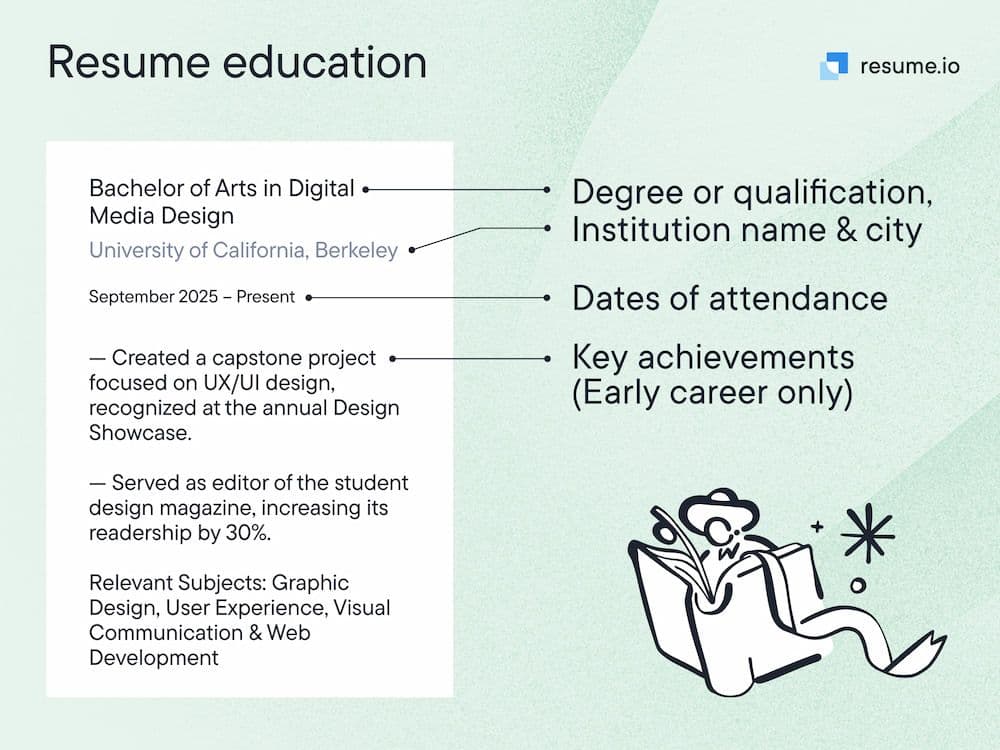Compared to other parts of your resume, the education section might seem fairly straightforward. But it’s important to make sure you’re including the information employers expect to see. A resume builder AI can help ensure your formatting is clean and your details are presented clearly.
We’ll show you how to list your education on a resume, including what details to mention and how to format this section.
Where to put education on a resume
Whether you’re a doctoral candidate or a high school student, you should include an education section on your resume. Typically, this section goes at the bottom of the document, below your work experience and core skills.
If you’re a recent graduate with no experience, you can move your education section above your work history. List your degree or diploma below your resume summary. This placement showcases the knowledge and skills you’ve gained in the classroom. As you begin working and gain professional experience, you can move your education further down your resume.

What to include in your resume education section

Employers expect to see specific information in your resume education section. Make sure you include these elements:
- The full name of your degree, certificate, or diploma
- The name of the school or institution
- The school’s location, including the city and state
Optionally, you can include your graduation date if you’ve recently finished school. If you’re working toward a degree or diploma, list your expected graduation date.
If you’re a current or recent student without much work experience, you can also provide other information about your education. These details can include relevant coursework, school projects, academic honors, or your GPA (if it’s at least 3.0 or higher).
Should you include your high school education?
If a high school diploma is your highest level of education, you should list it on your resume. You can also leave it on your resume if you’re a current high school or college student. If you’ve earned a college degree, however, you should remove your high school education from your resume.
In general, your education section can be longer when you’re just starting your career. Once you have several years or more of professional experience, you should remove non-essential details about your education, such as your coursework and attendance dates.
Your education section may also look slightly different depending on your academic background. We’ll break down how to put education on your resume in different circumstances, including:
- High school education
- GED
- Undergraduate degree
- Postgraduate degree
- Certifications and professional development courses
- Specialized situations
- Academic awards and honors
- Thesis or dissertation
High school diploma
Many jobs only require a high school diploma. If that’s your highest or most recent education, list the name of your high school and its location. Provide your graduation date if it’s within the last three years.
If you’re a current high school student, provide your expected completion date. You can also include other details, such as academic awards and extracurricular activities.
Check out the example below:
High School Diploma
Riverview High School | Bozeman, MT
2020 - 2024
- National Honor Society member, 2022–2024
- Varsity soccer captain, 2023–2024
- Volunteer tutor
General Education Development (GED)
A General Education Development (GED) certificate shows you have the same level of education as a high school graduate. If it’s your highest academic qualification, you should list it on your resume just like a diploma.
List the full name of the GED and the dates you earned it (if within the last three years). Provide your expected completion date if you’re currently working toward your GED.
Review this example of how to write education on a resume when you have a GED:
General Education Development Certificate
Expected May 2025
Undergraduate degree
Earning an associate or a bachelor’s degree can open the door to more job opportunities. On your resume, provide the full name of your degree and field of study. For example, write “Associate of Science in Accounting” or “Bachelor of Arts in Communications.” Include the name of the school you attended and the location.
Here’s an example of how to put an undergraduate degree on your resume:
Bachelor of Science in Engineering
University of San Francisco | San Francisco, CA
Postgraduate degree
For high-level jobs, you may need to have a postgraduate degree, such as a master’s or a doctorate. To list a postgraduate degree on your resume, provide the degree, concentration, school, and location. Include your expected graduation date if you haven’t yet completed the degree.
When applying for jobs, decide if your postgraduate degree is more relevant than your previous work experience. If it is, you can move your education above your employment history until you gain some experience in the field.
Should you put PhD or MBA after your name on a resume?
Yes, you can put your abbreviated degree title after your name at the top of your resume. This prominent placement is an easy way to show an employer you have the preferred qualifications for the role.
Check out this example of including a postgraduate degree on your resume:
Master of Business Administration
University of Texas at Arlington | Arlington, TX
Certifications and professional development courses
Formal education isn’t the only way you can learn and develop skills for your career. Ongoing education, such as certification and professional development courses, can show your commitment to lifelong learning.
Include certifications and courses in your resume education section if they’re relevant to the role you’re applying for. Provide the full name of the certification, the institution where you received it, and the expiration or renewal date.
Here’s how you can list a certification in your resume education section:
Bachelor of Science in Business
Ohio State University | Columbus, OH
Project Management Professional
Project Management Institute
March 2026
Specialized situations
In some cases, you might have academic qualifications that don’t fit neatly into one of the types above. Here are some specialized situations and how you can handle them on your resume:
If you didn't graduate
If you attended college but didn’t graduate, you can still include this education on your resume. List the name of the degree program, the school you attended, and the number of credits you earned. Below this information, you can also include relevant courses you completed.
Follow this example to include incomplete education on a resume:
University of Wisconsin-Madison | Madison, WI
Completed 60 credits toward a Bachelor of Science in Marketing
Relevant coursework: Market research, social media strategies, and business analytics
Multiple degrees or certifications
If you have multiple degrees, list your highest one at the top. A bachelor’s degree is higher than an associate degree, so it should go first on your resume. Additional credentials, such as certifications and courses, should go below your formal education.
For multiple degrees, use this resume education example:
Bachelor of Science in Nursing
University of Texas at Austin | Austin, TX
Associate of Science in Nursing
Austin Community College | Austin, TX
Basic Life Support
American Heart Association
June 2025
Advanced Cardiac Life Support
American Heart Association
June 2025
Ongoing education
If you’re currently a student, you should list your ongoing education on your resume. This information lets employers know you’re in school and working toward a degree.
Provide the name of your expected degree and when you plan to earn it. You can include other optional details, such as coursework, projects, scholarships, or extracurricular activities.
Should you list an internship in your education section?
If you’ve completed an internship while in college, put this experience in your work history section, not with your education. Including internships in your employment section shows a hiring manager you have practical, on-the-job experience.
Here’s an example of listing ongoing education on your resume:
Bachelor of Science in Computer Science
Arizona State University | Tempe, AZ
Expected May 2026
- Coursework completed: Software development, data structure and algorithms, cybersecurity fundamentals, and web application design
- President of the on-campus Computer Science and Engineering Club
- Collaborated with a four-person team to develop an AI-powered chatbot for the university’s IT department
Academic awards and honors
When you’re just starting your career or changing jobs, you may have limited experience to put on your resume. In this case, you can include some additional details in your education section, including academic awards and honors. Some potential awards and honors to mention in your education section include:
- National Honor Society
- Dean’s list
- Cum laude honors
- Honor roll
- Valedictorian or salutatorian
- Student of the month
- Scholarships
Include these honors in bullet points below the information about your diploma or degree. List the full name of the award, the presenting organization (if applicable), and the year you received it.
Check out the example below:
High School Diploma
Lakeside High School | Denver, CO
Expected May 2025
- National Honor Society member, 2023–2024
- Student of the Month, March 2023
- Honor Roll, 2022–2024
Thesis or dissertation
For academic or research-based roles, it’s common to mention the thesis or dissertation you completed while earning a postgraduate degree. Below your degree, list the full title of your thesis or dissertation. As an option, you include a short summary of your research and findings.
Review this example to include a thesis or dissertation on your resume:
PhD in Environmental Policy
University of California, Berkeley | Berkeley, CA
Dissertation: “Evaluating Climate Resiliency in Coastal Communities”
- Conducted field research in three U.S. coastal cities
- Prepared predictive models for flood management based on climate projections
- Published findings in a peer-reviewed journal
Full resume examples & templates for various seniority levels
How you list education on your resume may depend on your role and seniority level. For example, doctors complete many years of school to train in their specialty.
If you’re a doctor, you will have more information in your resume education section than someone working in an entry-level role.
Here are some examples of how to list education on a resume depending on your position and seniority:
Intern education section
Shop assistant education section
Doctor education section
CEO education section
Resume format to showcase education
There are three types of resume formats: chronological, functional, and hybrid (also known as combination).
The chronological resume format is the most common. It prioritizes your work experience, particularly your most recent positions.
If you have several years or more of work experience, you should use a chronological resume. Employers expect to see this format, and it works well with applicant tracking system (ATS) software. When formatting a chronological resume, you should put your education below your work experience and skills.
A functional resume, on the other hand, can be a good choice if you’re beginning your career or making a transition. It’s also the preferred format if you want to emphasize your recent education. On a functional resume, you can put your education section closer to the top, above your work experience.
The hybrid resume format blends elements of the chronological and functional resumes. It places equal importance on your skills and work experience, with your education at the bottom. If your career path has not followed a straight line, a combination resume can be a good choice to highlight your most relevant qualifications. However, it’s usually not the best option for showcasing your education.

Resume education FAQs
Here are the answers to other common questions about education on a resume:
How to write down your degree?
List the type of degree followed by your major or field of study. Here are some examples:
- Master of Arts in Digital Marketing
- Bachelor of Science in Construction Management
- Associate of Arts in Communications
Don’t use abbreviations unless they’re common in your field. For example, you can list MBA for Master of Business Administration or PhD for Doctor of Philosophy.
How to list your GPA on a resume?
If you’re a current student or a recent graduate, you can include your GPA if it’s 3.0 or above. List your GPA below the name of your degree or diploma.
How do you include a gap year on a resume?
If you worked during your gap year, include this experience in your work history section. Other activities, such as travel or volunteerism, can go in an additional section, such as “Personal Development” or “ Volunteer Work.”
You don’t need to include a gap year in your education section unless you took courses, earned a certification, or completed other learning during this time.
How far back should the resume education section go?
If you’re an early or mid-career professional, your resume should include all the formal education you’ve completed. It should also list any relevant and recent certifications or courses you’ve done.
As you advance in your career, you can (and should) remove graduation dates from your resume to prevent age discrimination. Additionally, you may remove a degree from your resume if it’s not relevant to your current role and you have many years of experience.
What are some common mistakes when listing education on a resume?
These are some common mistakes to avoid when listing education on your resume:
- Providing too many details. Unless you’re a current student or a recent graduate, you only need to provide the name of your academic credential, the school, and the location. When in doubt, keep the resume education format short and sweet.
- Leaving off certifications. Include all certifications you’ve earned that are relevant to the job. If you have several or more certifications, consider putting them in a separate section directly below your education.
- Focusing too much on education. Your resume should emphasize your professional experience and technical skills, especially if you’ve been out of school for a while. Some niche professions, such as those in academia, may prioritize education more heavily, but for most jobs, your experience will be what sells your resume.
Lying or exaggerating.
It’s easy for employers to verify your education, so never lie or exaggerate the truth on your resume. If you have limited education, be honest and prioritize your other qualifications, such as your skills and work experience.






